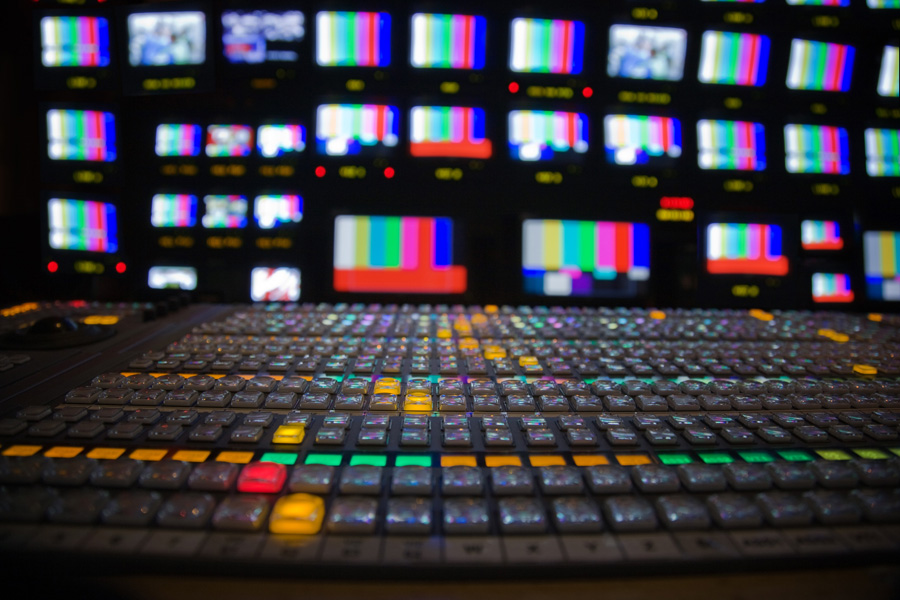Comprehending the Addition of Audio Visual Modern technology in Today's Educational Environments
The assimilation of audio-visual modern technology in educational settings has changed the mentor and discovering procedure. Educators now have access to devices that provide to various finding out designs, improving trainee interaction and cooperation. However, the unification of these technologies provides both opportunities and difficulties. Recognizing how to effectively carry out these tools is important. What techniques can educators utilize to make best use of the benefits of audio-visual innovation in their classrooms?
The Evolution of Audio-Visual Innovation in Education
As instructional demands developed over the years, audio-visual innovation undertook substantial improvements that improved the learning atmosphere. Tools such as movie projectors and slide programs were the key ways of integrating visual components into class. These very early innovations given instructors with the capability to present info dynamically, yet they were limited in accessibility and interactivity.
With the introduction of video clip cassette recorders in the 1970s, classrooms started to incorporate taped lessons, expanding the scope of academic resources. The introduction of individual computer systems in the 1980s more changed this landscape, permitting for the production of multimedia discussions and interactive learning experiences.
The surge of the web in the 1990s marked a turning point, allowing real-time accessibility to a wide range of audio-visual materials. Today, electronic devices such as interactive white boards and on the internet knowing platforms remain to enhance the educational experience, cultivating engagement and partnership amongst learners.
Advantages of Audio-Visual Equipment for Diverse Knowing Styles
Audio-visual tools play a crucial role in accommodating varied knowing styles by boosting visual knowing and boosting auditory interaction. By including pictures, video clips, and sound, these modern technologies produce an even more inclusive academic atmosphere. This diverse technique allows teachers to deal with the diverse preferences and needs of trainees effectively.
Enhancing Visual Understanding
Interaction in the learning procedure is substantially enhanced via the usage of audio-visual devices, satisfying different finding out designs. These devices, such as video clips, infographics, and interactive presentations, supply visual stimuli that aid comprehension and retention. Visual students, particularly, gain from the unification of photos and computer animations, which can streamline complex principles and enhance understanding. Additionally, audio-visual resources can highlight real-world applications, making finding out more appropriate and engaging. By integrating color, activity, and sound, instructors can develop a dynamic understanding environment that captures students' attention and fosters much deeper cognitive links. Ultimately, the critical use of audio-visual innovation not only supports visual learning however also improves the general educational experience for varied students.
Improving Auditory Interaction
A substantial benefit of incorporating audio-visual tools in education and learning is their capacity to boost auditory engagement amongst students. These devices, which incorporate multimedia presentations, podcasts, and interactive sound elements, satisfy different discovering designs, specifically benefiting acoustic students (audio visual charlotte nc). By integrating noise and narration, educators can produce immersive experiences that record students' focus and strengthen understanding. This involvement is crucial, as it promotes a much deeper understanding of the material and promotes retention. In addition, audio-visual tools can promote collective knowing environments, urging trainees to join conversations and share their insights. Ultimately, the consolidation of audio-visual innovation not just sustains auditory engagement however also enhances the total instructional experience, making finding out more dynamic and effective for all pupils
Enhancing Interaction With Interactive Learning

Gamification elements, such as quizzes and simulations, can improve inspiration and retention, making finding out a lot more delightful and efficient. These approaches not only promote cognitive engagement however likewise cater to varied knowing styles, making certain that all students can take part meaningfully. As a result, interactive understanding settings foster a feeling of area and belonging, ultimately leading to improved scholastic end results. With the integration of audio visual technology, educators can transform standard classrooms right into lively spaces where trainees flourish and actively form their educational journeys.
Connecting Theory and Exercise With Multimedia Resources
Multimedia sources function as a crucial web link in between theoretical concepts and practical application in academic settings. By boosting interaction, promoting collaborative understanding experiences, and sustaining diverse learning styles, these devices produce an extra inclusive and vibrant discovering setting - audio visual charlotte nc. This technique not just promotes much deeper understanding but also prepares pupils for real-world obstacles

Enhancing Engagement Via Multimedia
Engagement in instructional settings significantly increases when teachers integrate multimedia sources right into their teaching methods. Using videos, podcasts, and interactive discussions boosts the discovering experience, permitting pupils to connect with the product on multiple levels. Multimedia sources accommodate various finding out styles, offering aesthetic, auditory, and kinesthetic stimuli that can hold students' attention extra properly than traditional lecture approaches. In addition, these resources can simplify intricate concepts, making them much more available and memorable. By incorporating multimedia, educators can develop a vibrant class environment that promotes inquisitiveness and inspires students. Eventually, the calculated use audio-visual technology offers to bridge the void between theoretical understanding and useful application, improving the academic experience for both trainers and pupils.
Assisting In Collaborative Understanding Knowledge
Many research studies show that joint learning experiences markedly improve pupil end results when incorporated with multimedia sources. Multimedia tools assist in interaction among students, permitting them to involve in problem-solving and critical thinking collectively. By using video conferencing, joint systems, and interactive presentations, educators develop atmospheres helpful to teamwork and shared understanding. These technologies allow students to connect their concepts effectively and get prompt feedback, promoting a much deeper understanding of the subject. Additionally, multimedia sources can offer intricate principles in even more digestible styles, advertising discussion and partnership. As a result, the combination of joint discovering and audio-visual modern technology not just improves the academic experience but likewise prepares pupils for real-world teamwork dynamics, emphasizing the value of cooperation and cumulative understanding building.
Supporting Diverse Understanding Styles
While traditional mentor techniques typically satisfy a restricted array of discovering choices, the integration of audio-visual innovation offers a more inclusive method to education and learning. By employing multimedia sources such as video clips, interactive simulations, and electronic discussions, instructors can attend to different discovering styles, including visual, auditory, and kinesthetic. This flexibility permits distinguished direction, enabling students to involve with web content in means that resonate with their private preferences. In addition, audio-visual devices can facilitate much deeper understanding by offering several representations of intricate principles. As a result, students that might have problem with traditional methods can discover alternative paths to success, promoting a more fair knowing atmosphere that sustains academic success for all students.
Challenges in Implementing Audio-Visual Innovation
Although audio-visual technology holds great assurance for enhancing educational experiences, its execution often experiences significant difficulties. One primary issue Clicking Here is the economic problem associated with buying and keeping such equipment, which can strain spending plans, especially in underfunded establishments. Additionally, poor training for teachers can impede reliable integration, leaving them ill-prepared to utilize the technology fully. Technical issues, such as software application breakdowns and compatibility problems, may likewise interfere with lessons and discourage both teachers and trainees. Differing degrees of pupil accessibility to technology outside the classroom can produce disparities in discovering possibilities. The capacity for over-reliance on modern technology might take away from important mentor techniques, eventually limiting the educational experience. Resolving these obstacles calls for a complete technique, including adequate financing, expert development, and fair access to sources, to assure that audio-visual innovation can be leveraged effectively in today's instructional settings.
Ideal Practices for Integrating Innovation in the Classroom

Furthermore, cultivating an interactive setting through collective devices encourages trainee involvement and participation. Utilizing diverse audio-visual sources satisfies different learning designs, fitting aesthetic, auditory, and kinesthetic students. On a regular basis assessing the impact of modern technology on pupil knowing assists teachers fine-tune their strategies and adjust to changing needs. Including pupils in the option of modern technology advertises ownership and inspiration. By sticking to these finest methods, educators can create a vibrant class environment that successfully integrates technology and enhances the instructional experience for all trainees.
The Future of Audio-Visual Innovation in Education
As classrooms progressively embrace modern technology, the landscape of audio-visual devices in education continues to evolve (audio visual charlotte nc). Future advancements are anticipated to focus on higher interactivity and customization, allowing instructors to tailor learning experiences to specific pupil needs. Developments such as increased truth (AR) and online truth (VIRTUAL REALITY) will likely give immersive understanding settings, enhancing student engagement and understanding
Artificial intelligence (AI) is positioned to play a considerable role in audio-visual modern technology by providing real-time find responses and adaptive understanding pathways. This integration might assist teachers recognize and deal with pupil difficulties extra properly. Cloud-based platforms will help with much easier access to resources and collaboration amongst students and instructors, despite place.
In enhancement to these technological breakthroughs, professional development for educators will certainly be vital, guaranteeing they are geared up to utilize look these up these devices effectively. In general, the future of audio-visual modern technology in education promises to develop even more vibrant, comprehensive, and impactful knowing experiences.
Often Asked Concerns
Just How Can Educators Pick the Right Audio-Visual Devices for Their Class?
Picking proper audio-visual devices calls for educators to assess their educational goals, consider student requirements, review available technology, and seek suggestions from peers or professionals, guaranteeing tools efficiently improve discovering and interaction within their certain classroom environment.
What Budget Factors to consider Are There for Carrying Out Audio-Visual Modern Technology?
Budget factors to consider for implementing audio-visual technology include initial acquisition prices, maintenance expenses, training for personnel, and prospective software application licensing costs. Furthermore, long-term investment in updates and replacements ought to also be factored into financial preparation.
Are There Certain Training Resources for Educators on Audio-Visual Devices?
Many institutions offer training resources for educators on audio-visual devices, including on the internet courses, workshops, and instructional overviews. These resources intend to boost teachers' skills and self-confidence in properly integrating technology right into their mentor practices.
Exactly how Do We Measure the Performance of Audio-Visual Technology in Understanding?
Determining the performance of audio-visual technology in finding out entails reviewing pupil engagement, comprehension, retention prices, and general scholastic performance. Studies, analyses, and observational researches can give important understandings into its effect on educational end results.
What Are Common Misunderstandings Concerning Audio-Visual Innovation in Education And Learning?
Common misconceptions regarding audio-visual modern technology in education and learning consist of the idea that it assures interaction and finding out end results, along with the assumption that all pupils benefit just as, ignoring specific discovering choices and demands.